India Hosts the 21st International Solving Contest in Four Cities
India hosted the 21st International Solving Contest on January 19th, bringing together over 200 solvers across four cities: Mumbai, Bhopal, Chennai, and Bengaluru. The contest featured three categories – highly experienced, less experienced, and junior – catering to solvers of all levels. ChessBase India successfully organised the Mumbai and Bhopal legs of the event, with Dr. Vidhi Karelia and Satanick Mukhuty leading the efforts. In this pictorial report, we delve into the highlights of the contest, presenting a visual recap of all four tournaments. Furthermore, to put your skills to the test, we have included a 'Test Yourself' section featuring five problems from the contest.
The International Solving Contest Comes to Mumbai and Bhopal!
While opinions may differ, many consider India the epicentre of chess today. Historians also attribute the game's origins to India – and given the country's remarkable achievements in the past decade, it's fitting to say that chess has come full circle, returning to its ancestral home. Yet, in the intriguing realm of chess composition and solving, India remains to replicate the dominance that it has shown in over-the-board chess. Notably, the country lacks any titled solvers, and aside from a handful of problem composers in Southern India, chess composition remains largely unknown in the rest of the country. A simple yet impactful step towards changing this is to host more solving tournaments. The introduction of the International Solving Contest this January in two new Indian cities – Mumbai and Bhopal – marked a significant stride in that direction.
The International Solving Contest (ISC) is a chess-solving spectacle like no other – a thrilling annual showdown that unfolds simultaneously across the globe on a Sunday in late January. This year, it took place on the 19th of the month and saw a record-breaking number of participants, from top solvers to novices worldwide, putting their critical thinking to the test. India has traditionally hosted the event in Chennai and Bengaluru; however, in a significant expansion, the latest edition successfully debuted in Mumbai and Bhopal, courtesy of ChessBase India. In Mumbai, Dr. Vidhi Karelia oversaw the event as local controller. Meanwhile, Satanick Mukhuty was at the helm of organising the contest in Bhopal. The two venues collectively attracted a turnout of about 70 solvers.
Vidhi's debut as a contest coordinator wasn't without its challenges. The event was slated to take place at the Atrium 5 of the Phoenix Market City Mall in Kurla, the designated hub for ChessBase India Club in Mumbai. However, a miscommunication with the mall authorities led to an unexpected hitch: the venue was found unprepared. Quick thinking and swift troubleshooting ensued, and the contest was promptly relocated to Dublin Square on the first floor of the same building. Although the proceedings were delayed by an hour or two, the event ultimately got back on track.
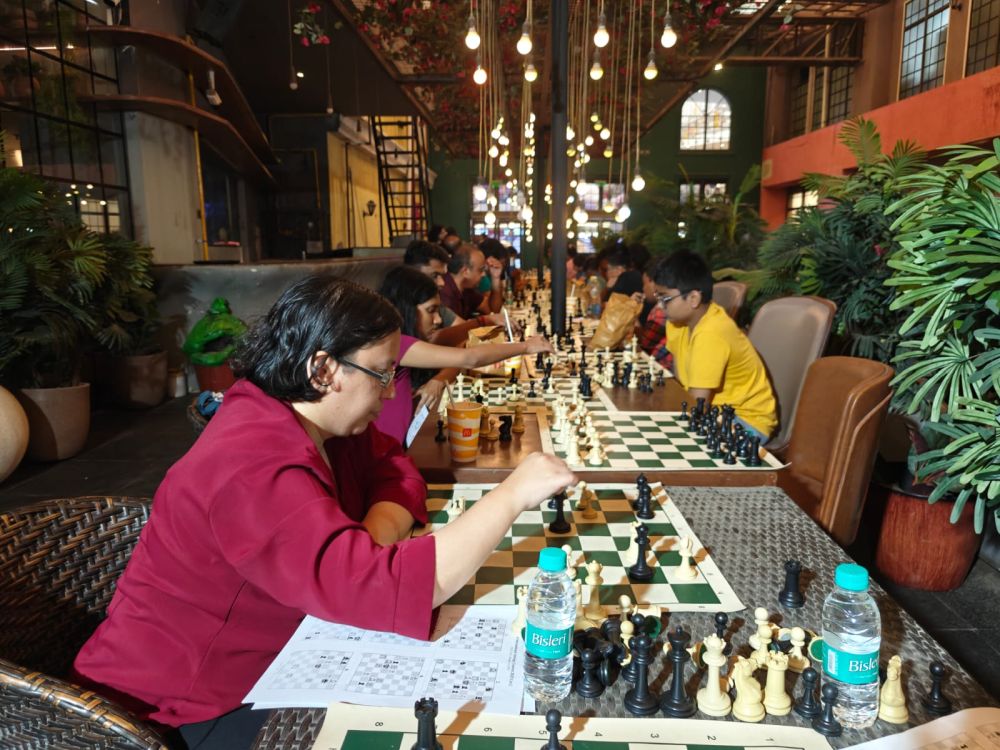
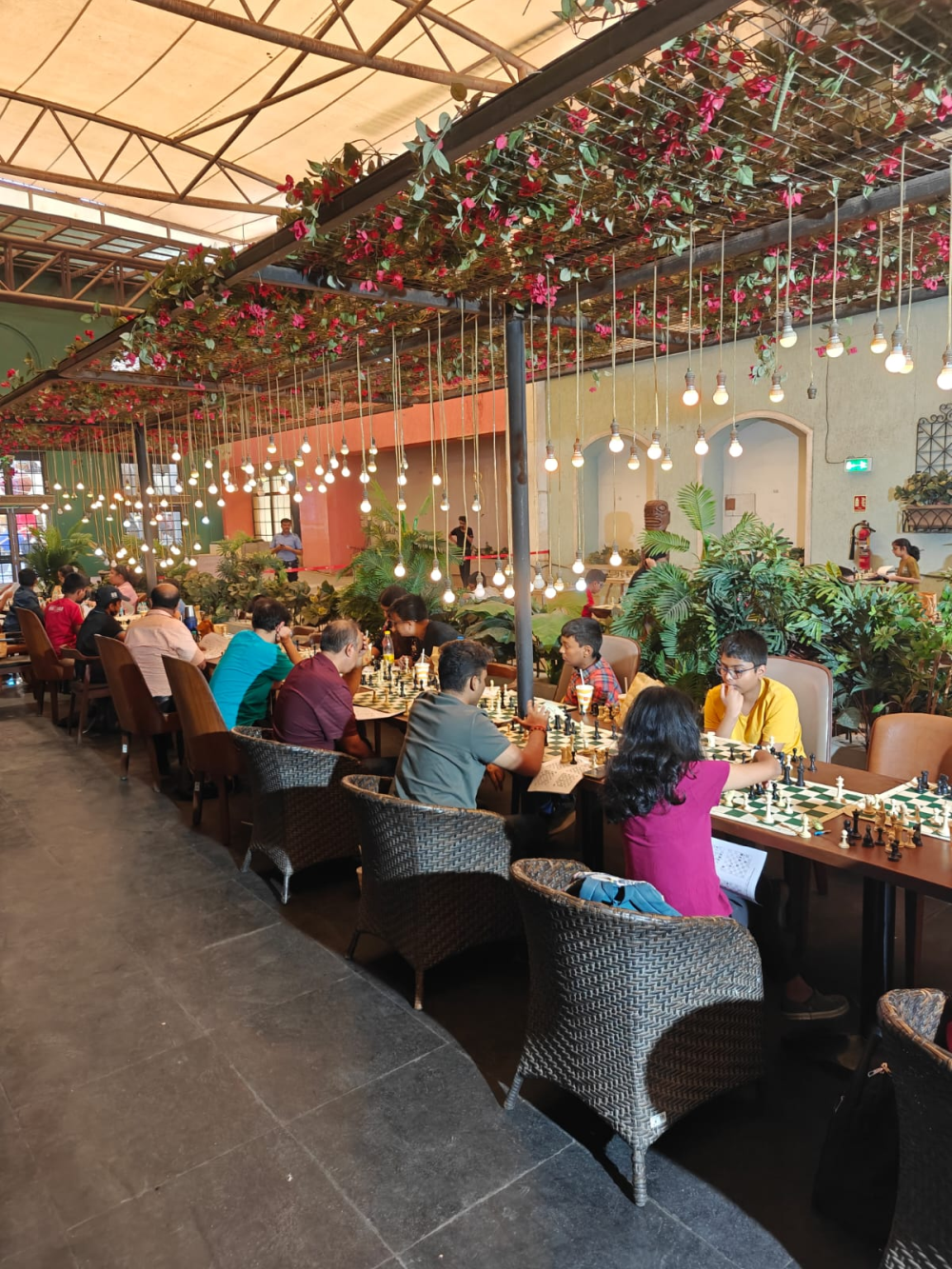
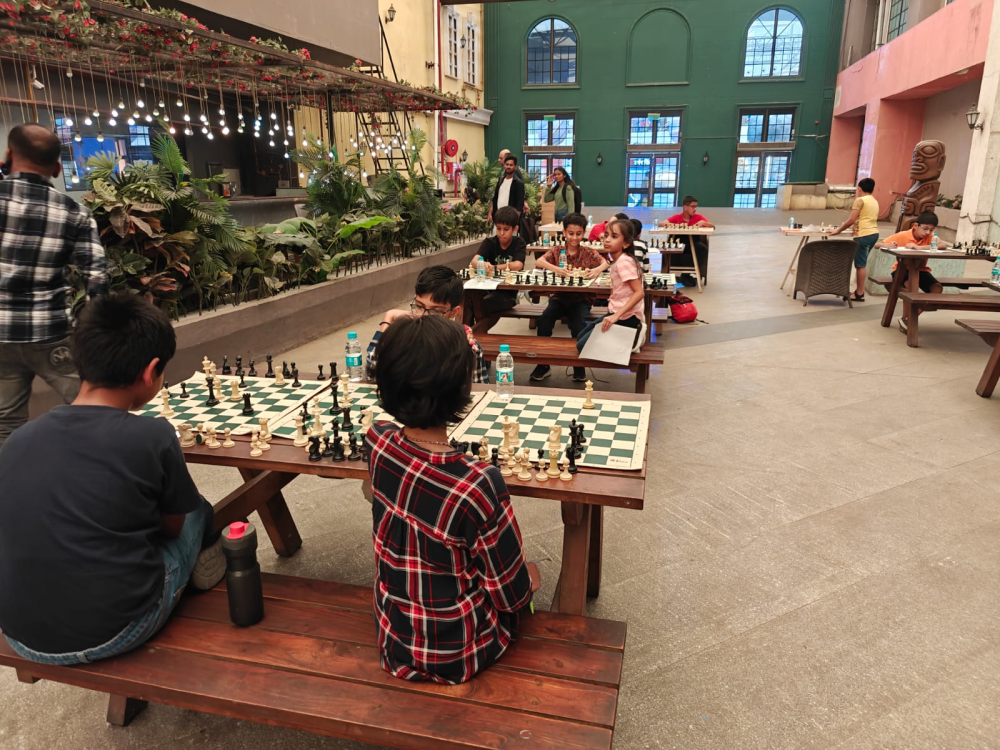
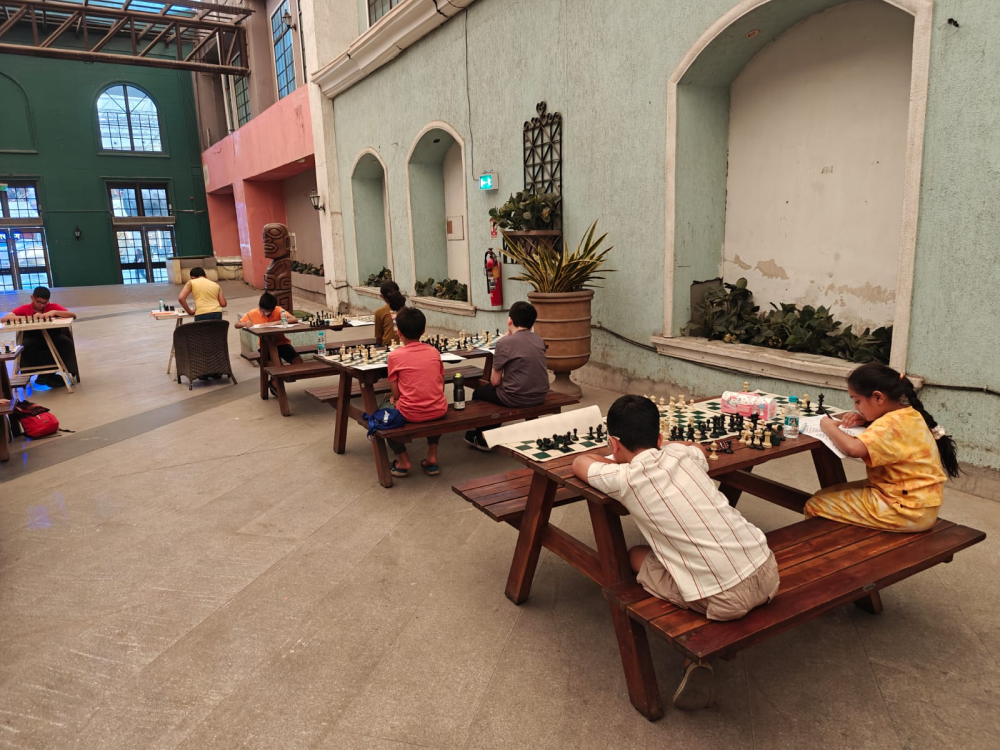

In Bhopal, the event organisation was seamless, thanks to the ideal setting of the Khelo Chess India Club. Nestled within the sprawling Sage International School campus, the club provided a vibrant and dynamic atmosphere, perfect for the occasion. Here, too, most young participants and their parents left with a positive impression, curious to know more about solving and chess composition.
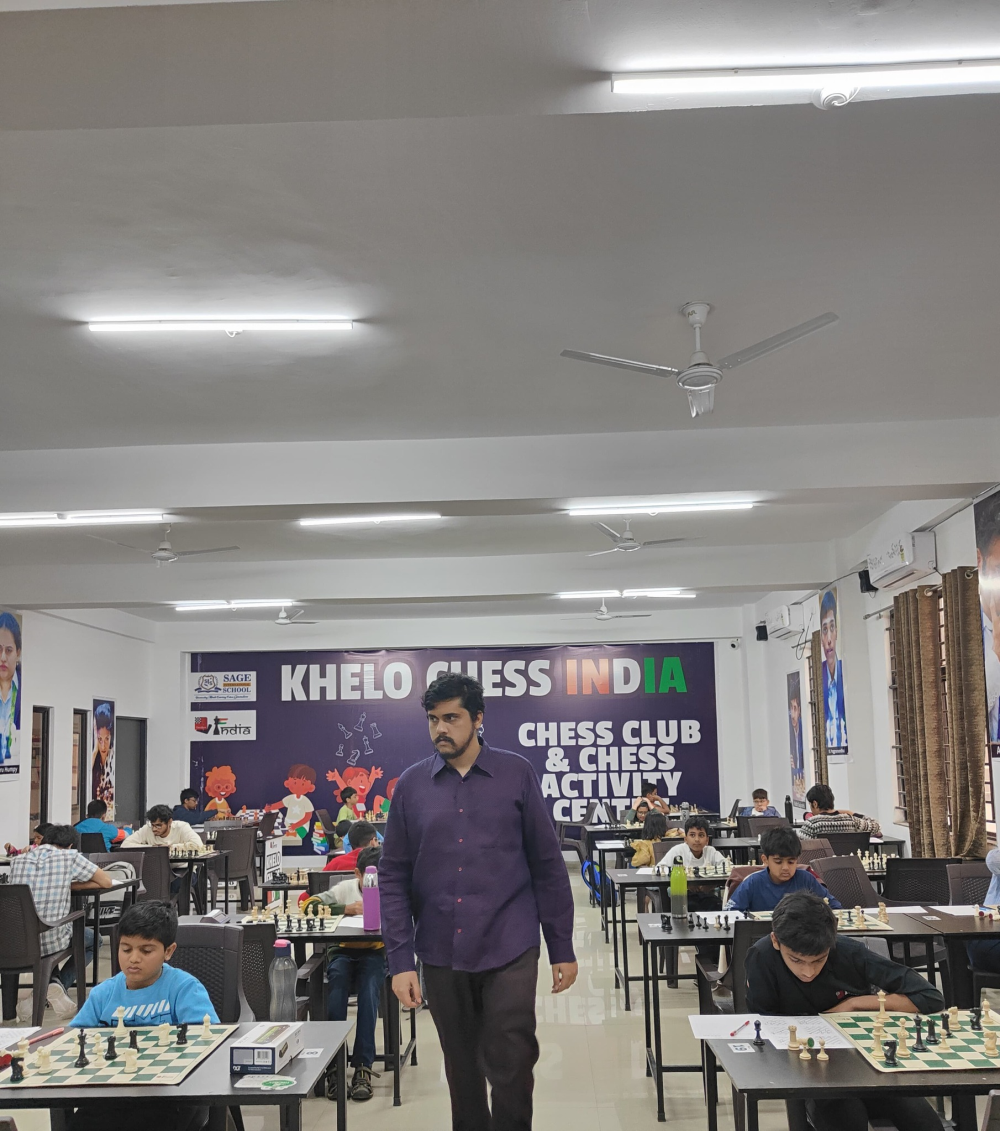
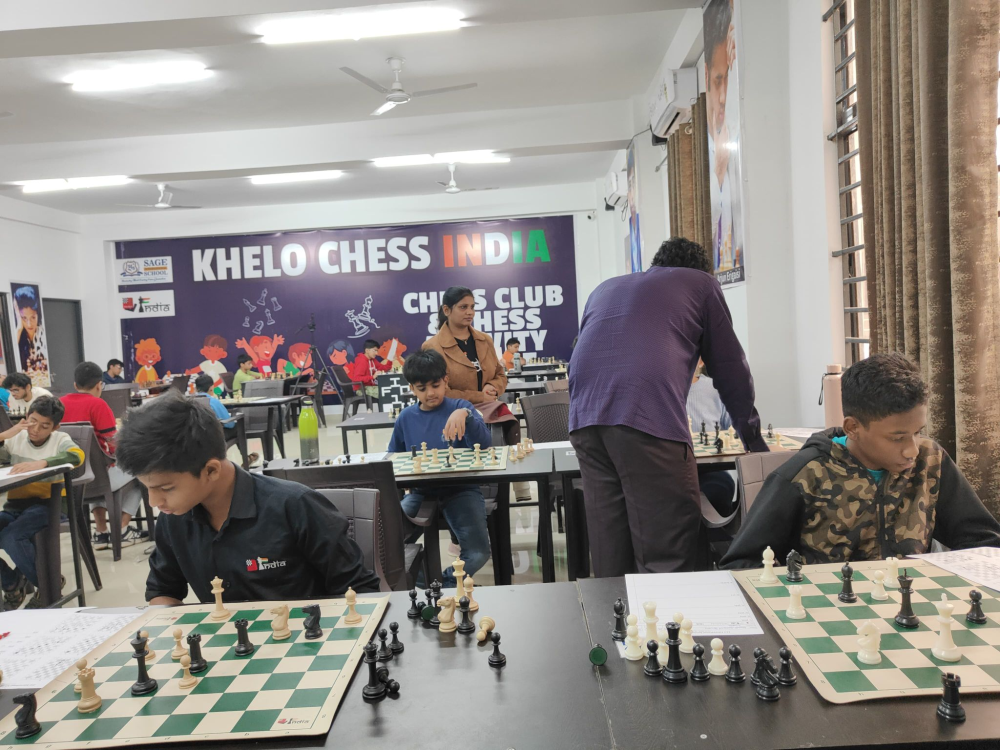
Performance: How did the Participants Do?
The competition was divided into three categories. Category 1 was designed for highly experienced solvers, while Category 2 catered to those with less experience. Category 3 was reserved for junior solvers, open only to those born after December 31, 2011. Most solvers in Mumbai and Bhopal participated in Categories 2 and 3. Overall, the performance left much to be desired. Mumbai's Aansh Nerurkar stood out as the only participant to achieve a 50% score across all categories. With a score of 24/30, he emerged as the clear leader in the junior category, far surpassing his closest contenders, Arjun Prabhu and Aarav Vagal, who both scored 12.5/30. In Bhopal, Arnav B Kumar delivered a standout performance, scoring 28/60 in Category 2, narrowly missing the 50% mark by just two points. Other notable performances in this category came from Mihir Naik (20.75/60), Yug Jain (19.25/60), Shaurya Mokal (19.25/60), and Vishwanath Angne (16/60) – all youngsters born in or after 2010! For detailed results, please find the link at the end of this article.
Test Yourself: Challenges from the Contest!
At the heart of any solving contest are the problems themselves. To give you a deeper insight, we will explore a few examples from the event. See if you can crack them! Take your time to think them through before reviewing the detailed solutions.
1.
Selim Achbar, Apprenti Sorcier, 1994
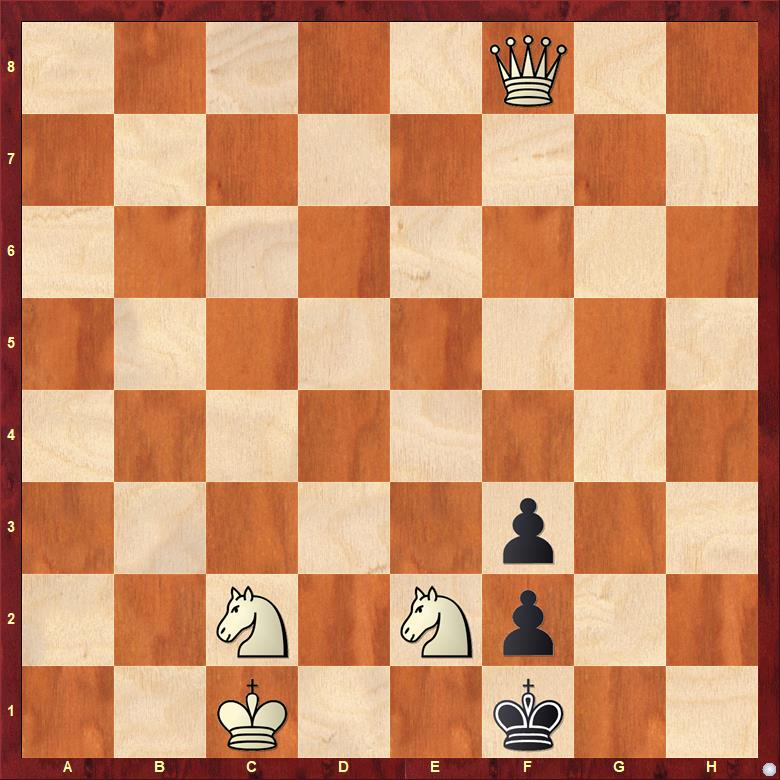
The above was the first problem in Category 3, the junior category. Here, an experienced solver would know at a glance that the queen should make the key. However, pinpointing which square exactly it must move to requires considerable scrutiny. Let's begin by analysing a few possibilities:
1.Qa8 appears promising, offering two attractive lines: 1...Kxe2 2.Qa6# and 1...fxe2 2.Qh1#, but proves insufficient only due to 1...Kg2!
Does the other corner move work? 1.Qh8 is another near-miss. Now 1...Kg2 and 1...fxe2 are addressed by 2.Ne3# and 2.Qh1#, respectively, but 1...Kxe2! refutes mate-in-2.
1.Qg8 takes away the flight square g2 from the black king, while preparing to meet 1...Kxe2 with 2.Qc4#. However, this time 1...fxe2! throws a spanner in the works.
Thus, by elimination, we arrive at the only queen move that works: 1.Qh6! (zugzwang). As the following variations demonstrate, this move niftily combines the benefits of all the previous attempts but incurs none of their pitfalls: 1...Kg2 2.Ne3#, 1...Kxe2 2.Qa6#, and 1...fxe2 2.Qh1#. A neat miniature!
2.
Josef Kupper, Neue Zürcher Zeitung, 1987
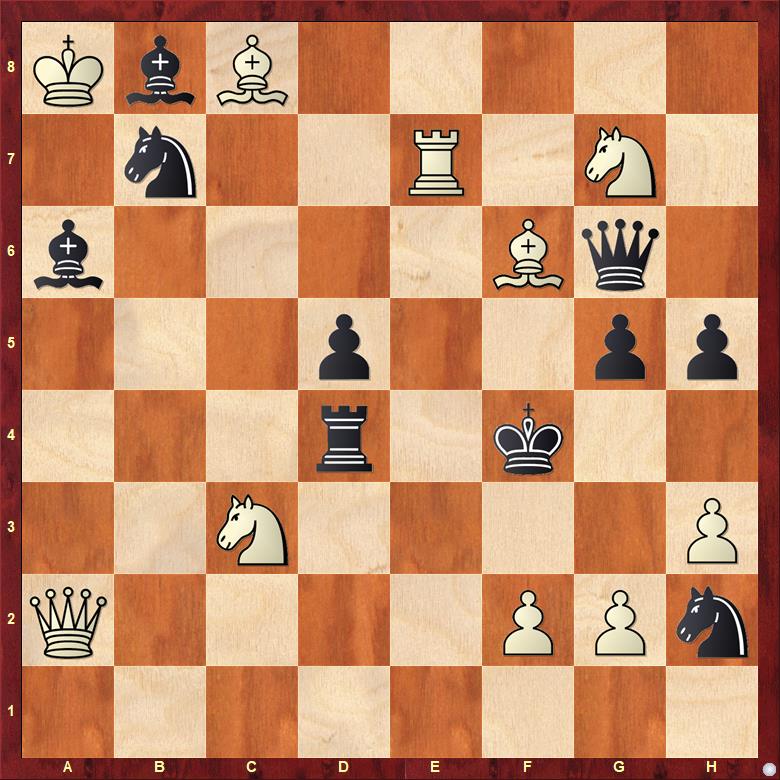
Stepping up the challenge, here is a weightier, more intricate two-mover from Round 2 of Category 1. Yet again, a horde of tries vie for attention. Let's go through them one by one:
1.Qe2 – a queen sacrifice! – is obviously enticing. This threatens 2.g3# and 2.Qe3#, while preparing to meet 1...Bxe2 with 2.Nxe2#. However, the subtle 1...Rd3! thwarts mate-in-2.
Also tempting is 1.Qxd5, threatening 2.Ne6# and 2.g3#. Here, 1...Rxd5 is answered by 2.Nxd5#, but the delicate 1...Re4! parries both the threats and refutes mate-in-2.
Another sacrificial attempt is 1.Qa4, which pins the d4 rook, threatening 2.Nxd5#. But now 1...Bc4 foils White's plan.
The key is 1.Qb1!, threatening 2.Ne6#. Now 1...Rd3 and 1...Bd3 are met with 2.Ne2# and 2.Qc1#, respectively, owing to Grimshaw interference on d3. Other variations include 1...Re4 2.Nxd5#, 1...Qxg7/Qf7 2.Qf5#, 1...Qxb1/Qxf6 (or any other defence with the g6 queen) 2.Nxh5#, and 1...Nd8/Nc5 2.Qxb1#. The last line demonstrates why 1.Qc2, which has the same threat as the key move, fails to work. Without the queen on the b-file, there is no mate after 1...Nd8 or 1...Nc5. Devious!
3.
Karel Musil, Světozor, 1889
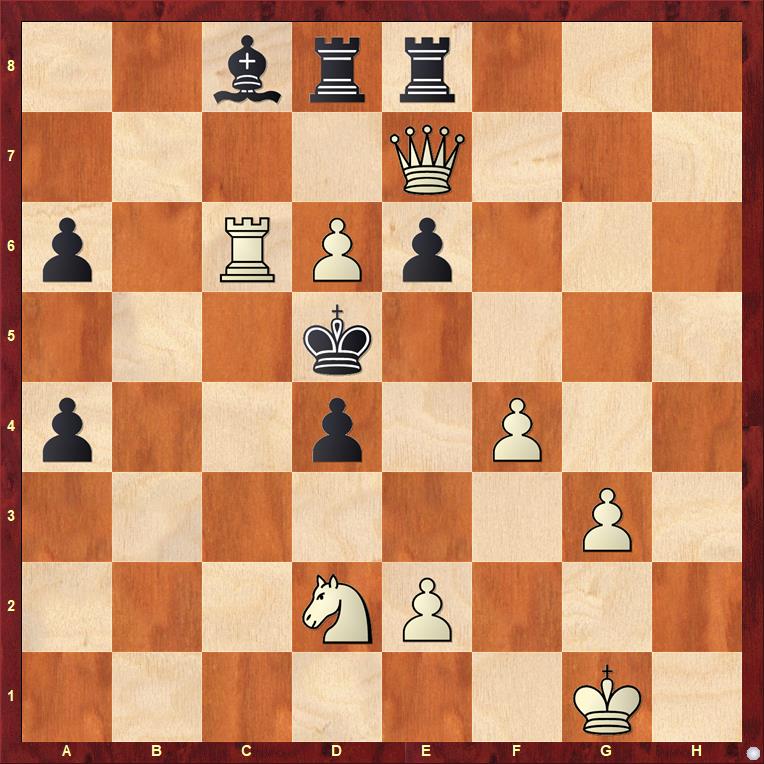
Next, we examine a pair of three-movers, beginning with a good, old-fashioned Bohemian problem from the 19th century, which was posed in the first round of Category 2.
For once, we don't need to bother analysing tries. The solution here begins with the delightful and intuitive 1.Ne4!, threatening 2.Rc5+ Kxe4 3.Re5#. In the ensuing variations, the queen springs into action, utilising the full expanse of the board:
1...Kxc6 2.Qc7+!
2...Kd5 3.Nf6# Model mate
2...Kb5 3.Qc5# Model mate
1...Kxe4 2.Qh7+!
2...Ke3 3.Qd3#
2...Kd5 3.Qh1# Model mate
1...d3 2.Nc3+!
2...Kd4 3.Qa7#
2...Kxc6 3.Qc7# Model mate
A bunch of nice mates!
4.
Peter Sickinger, Freie Presse, 2011
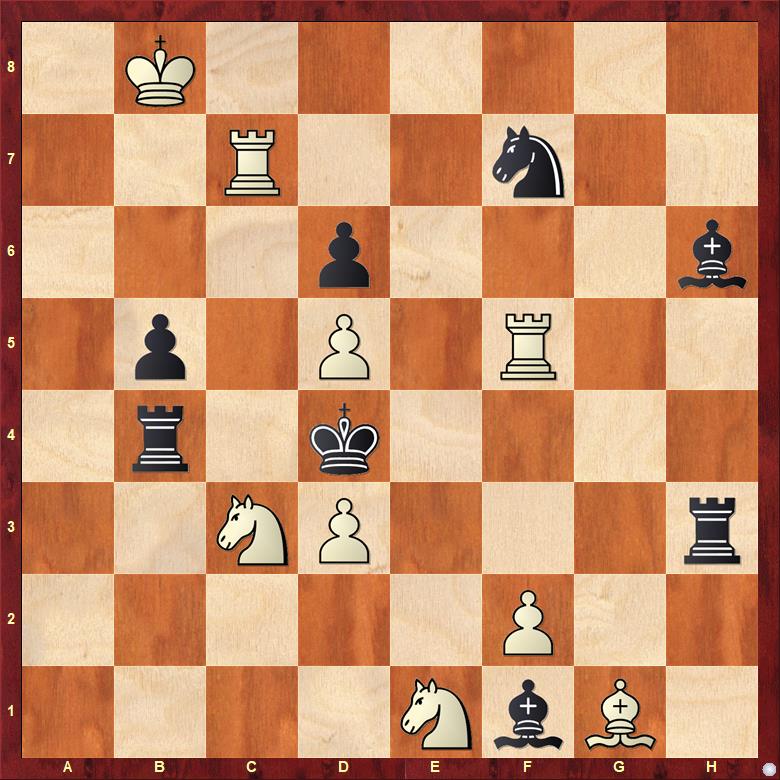
Here's another fun little three-mover from Round 2 of Category 2. Notice the bishop on g1, nicely lined up against the enemy king – a clear indication that a pawn push, f2-f3+ or f2-f4+ (or both!), will be crucial to the solution. However, it goes without saying, the direct attempts 1.f3+ and 1.f4+ do not help. Thus, what White needs is a preparatory move for these pawn pushes to succeed.
The key is the unassuming 1.Kc8!, setting up the threat 2.Nxb5+ Rxb5 3.Rc4#. If Black defends with 1...Ne5, then comes 2.f3+! Be3 3.Rf4# (pin-mate). Similarly, 1...Bxd3 is met by 2.f4+! Re3 3.Nf3# (pin-mate). In each variation, Black guards the c4 square, but ends up blocking a potential escape square (e5 or d3) of their own king (self-block), which is precisely what White exploits. Clever!
5.
Milan Vukcevich, US Problem Bulletin 1993, 1st Prize
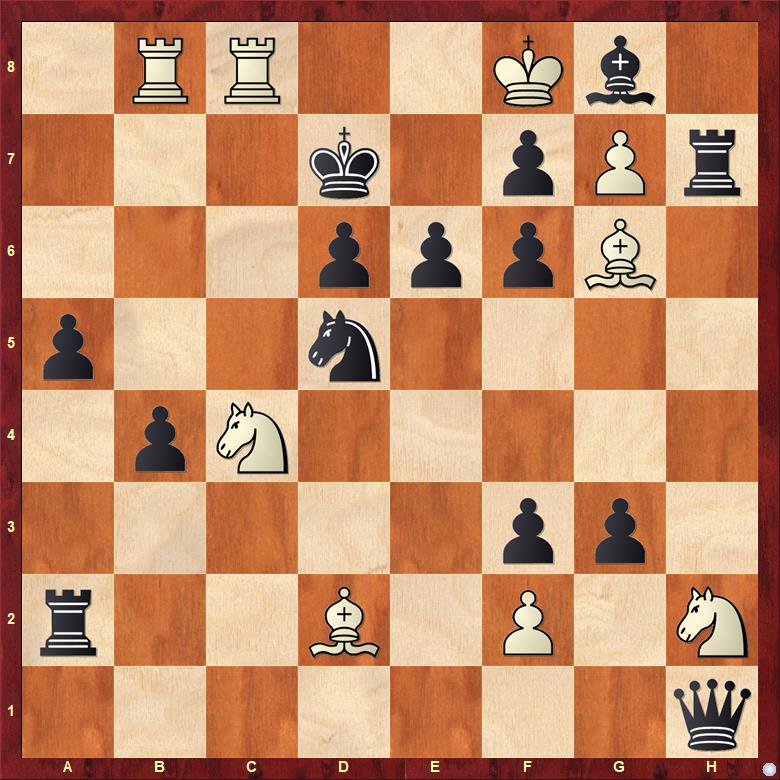
We wrap up this section with a logical more-mover (from Category 1, round 1). For longer problems like this, the best approach most often is to search for short, tactical threats that lead to quick mate in one or two moves. In this case, there are a couple of promising options that fit the bill. X-raying the squares b5 and c6, the moves 1.Bd3 and 1.Be4 threaten quick mates with 2.Nb6+ Nxb6 3.Bb5 and 2.Nb6+ Nxb6 3.Bc6, respectively. But in each case, Black has an adequate defence, refuting the quickest mate. After 1.Bd3 Qf1! or 1.Be4 Rc2!, there is no mate in six moves.
The key instead is 1.Ng4!, threatening 2.Nb6+ Nxb6 3.Nxf6# and 2.Nxf6+ Nxf6 3.Nb6#. Black can defend in two ways, both of which involve guarding f6 with the queen, resulting in the following lines:
1...Qa1 2.Be4! Rc2 3.Bc3! Plachutta
2...Qxc3 4.Nb6+ Nxb6 5.Bc6+ Qxc6 6.Nxf6#
And
1...Qh4 2.Bd3! Rh5 3.Bg5! Plachutta
3...Qxg5 (3...Nc7 4.Rd8+ Kc6 5.Rxd6+ Kc5 6.Be3#) 4.Nb6+ Nxb6 5.Bb5+ Qxb5 6.Nxf6#
Notice how the previously ineffective tries (1.Bd3 and 1.Be4) become successful once the black queen is deflected to either a1 or h4. Deep!
Stories from Chennai and Bengaluru
The ISC in Chennai was organised by V. Ravichandran, who acted as the local controller. Dubbed as India's chess capital, the city attracted a fair number of notable chess players to the event. Category 1 saw the participation of two luminaries from the playing world: Grandmasters Aravindh Chithambaram and Karthikeyan Murali, both also former National Champions. Notably, another strong player who graced the event in the same category was International Master Harikrishnan A. Ra.
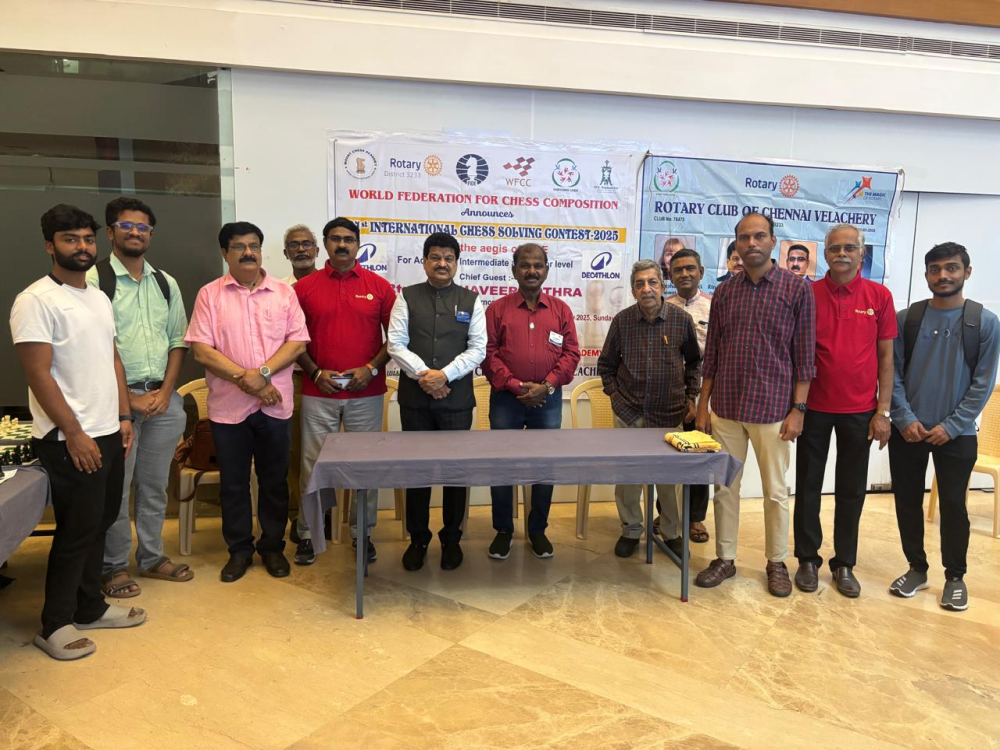
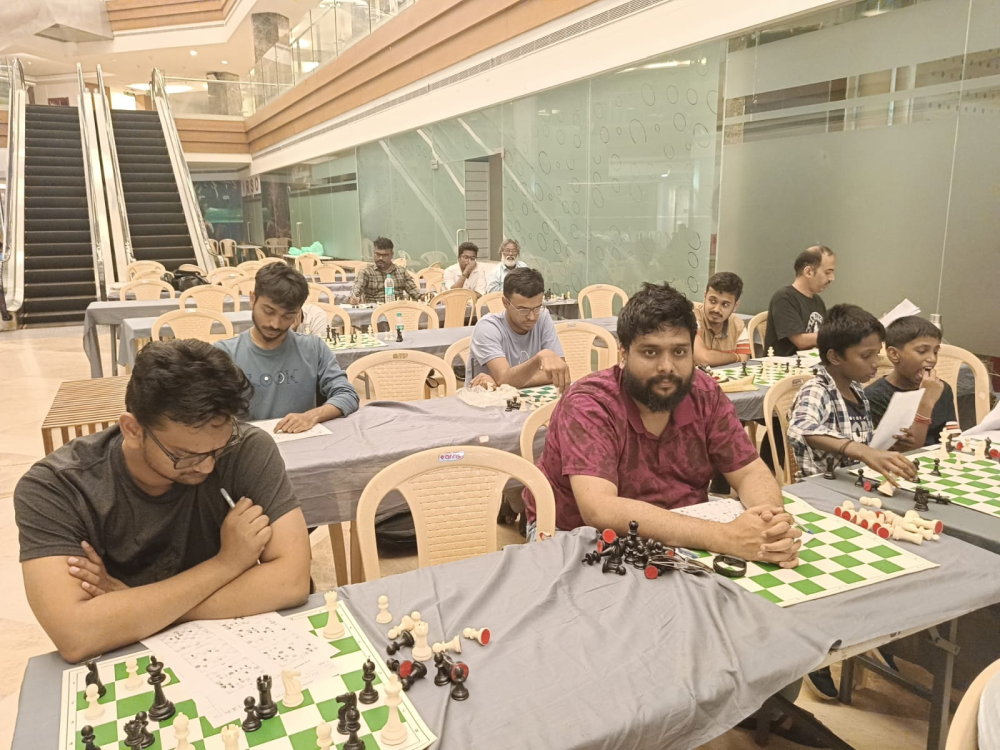
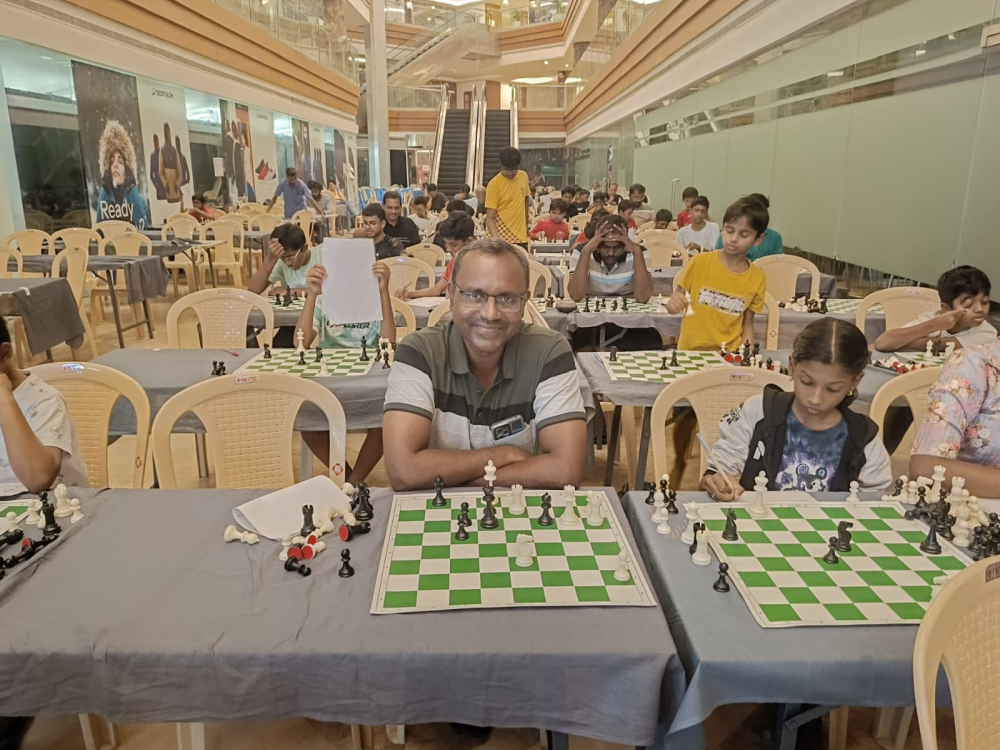
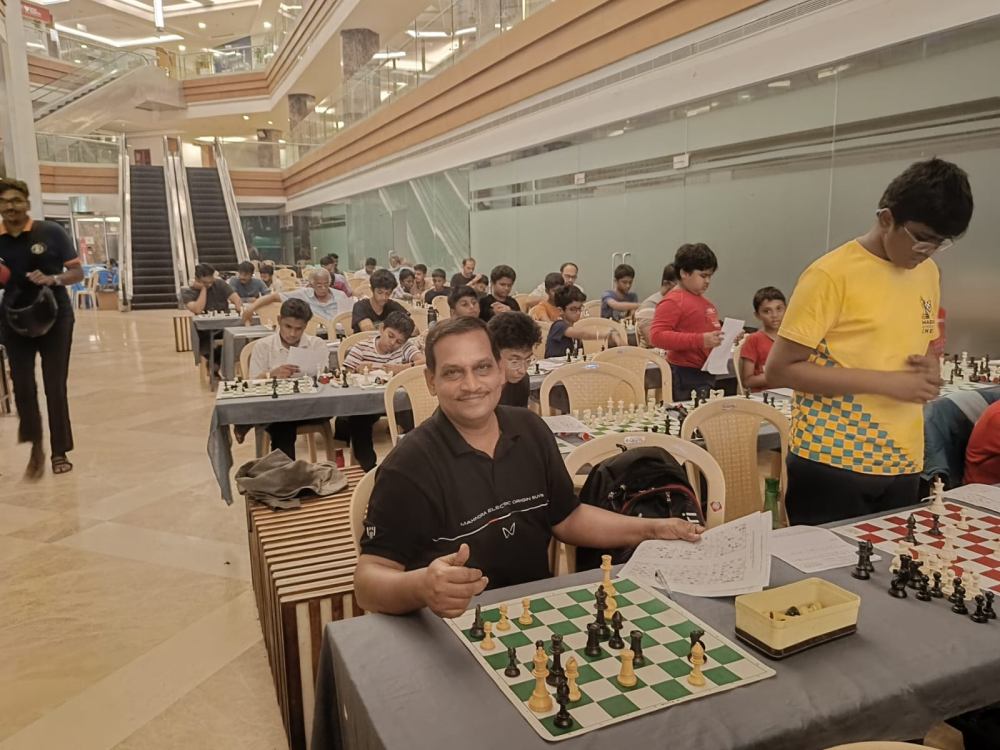
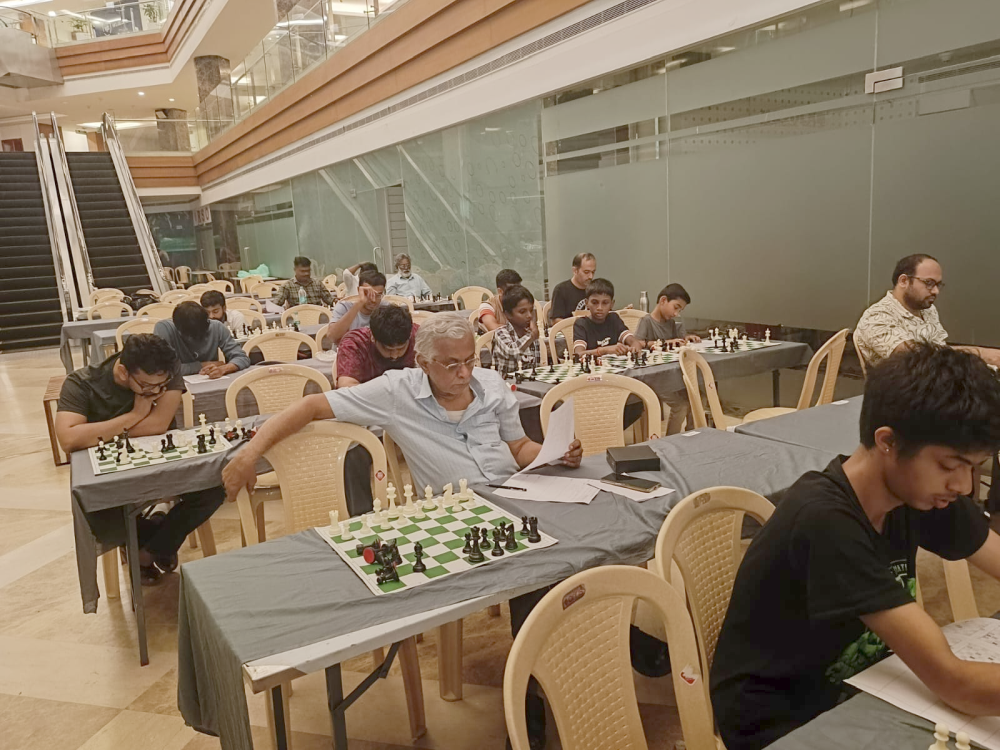
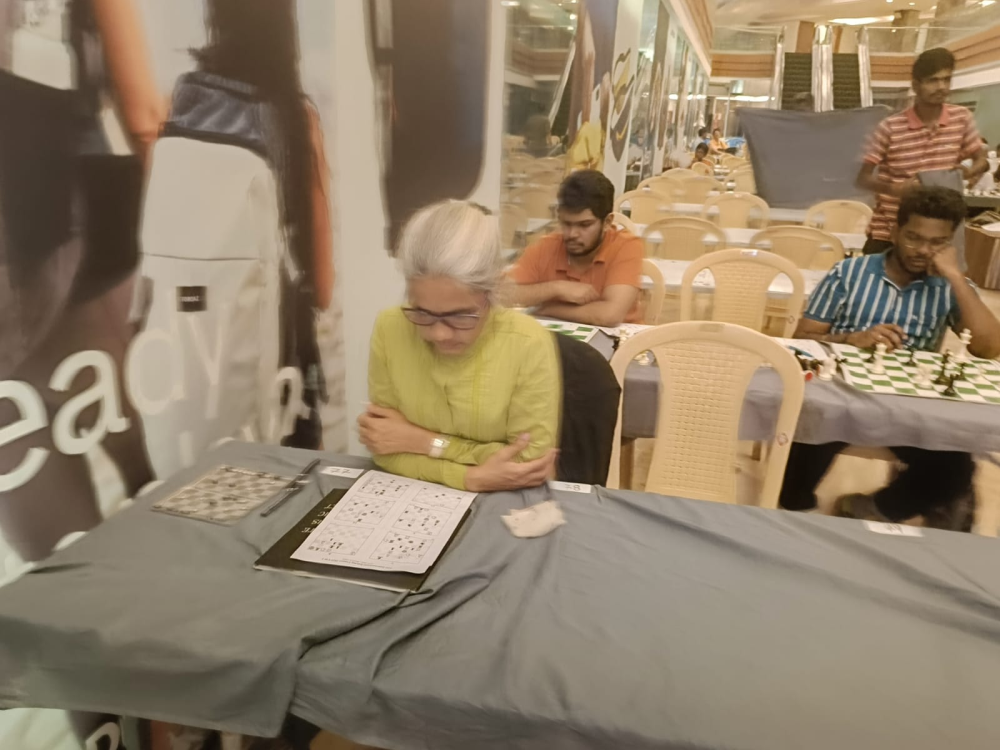
In Bengaluru, the event was successfully coordinated by Narayan Shankar Ram, India's first International Master of chess composition. A glimpse of the action, captured below:
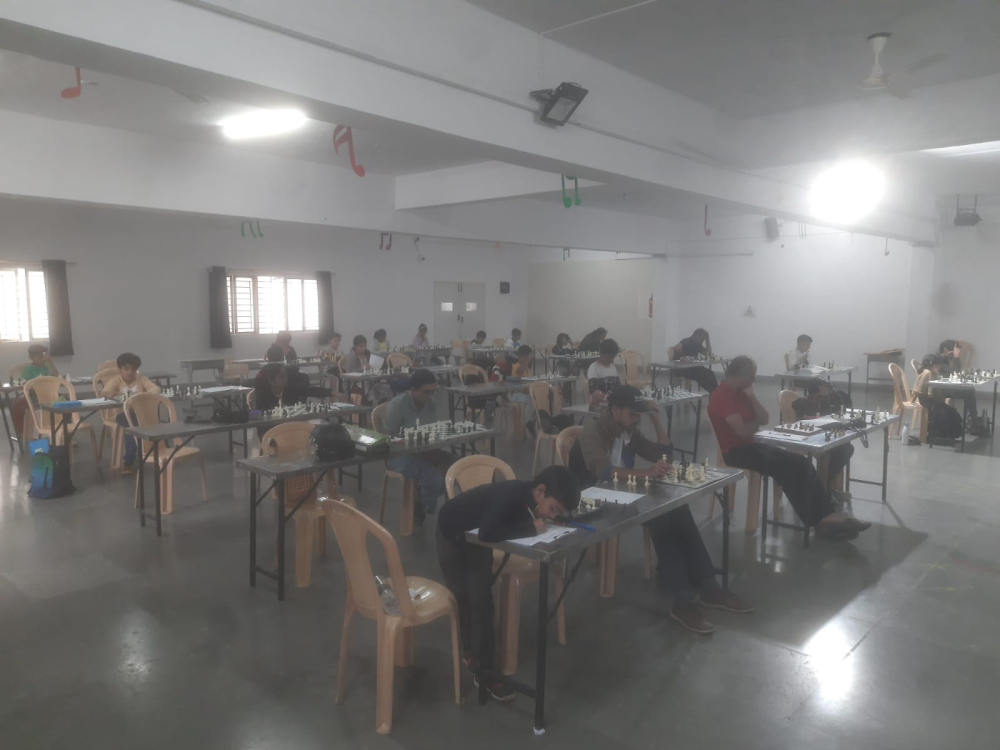
Important Links
2. Announcement of the 21st International Solving Contest in Bhopal and Mumbai.
Your thoughts, feedback, and comments on this article are welcome! Please feel free to email the author at chessbaseindiasocial@gmail.com.












































